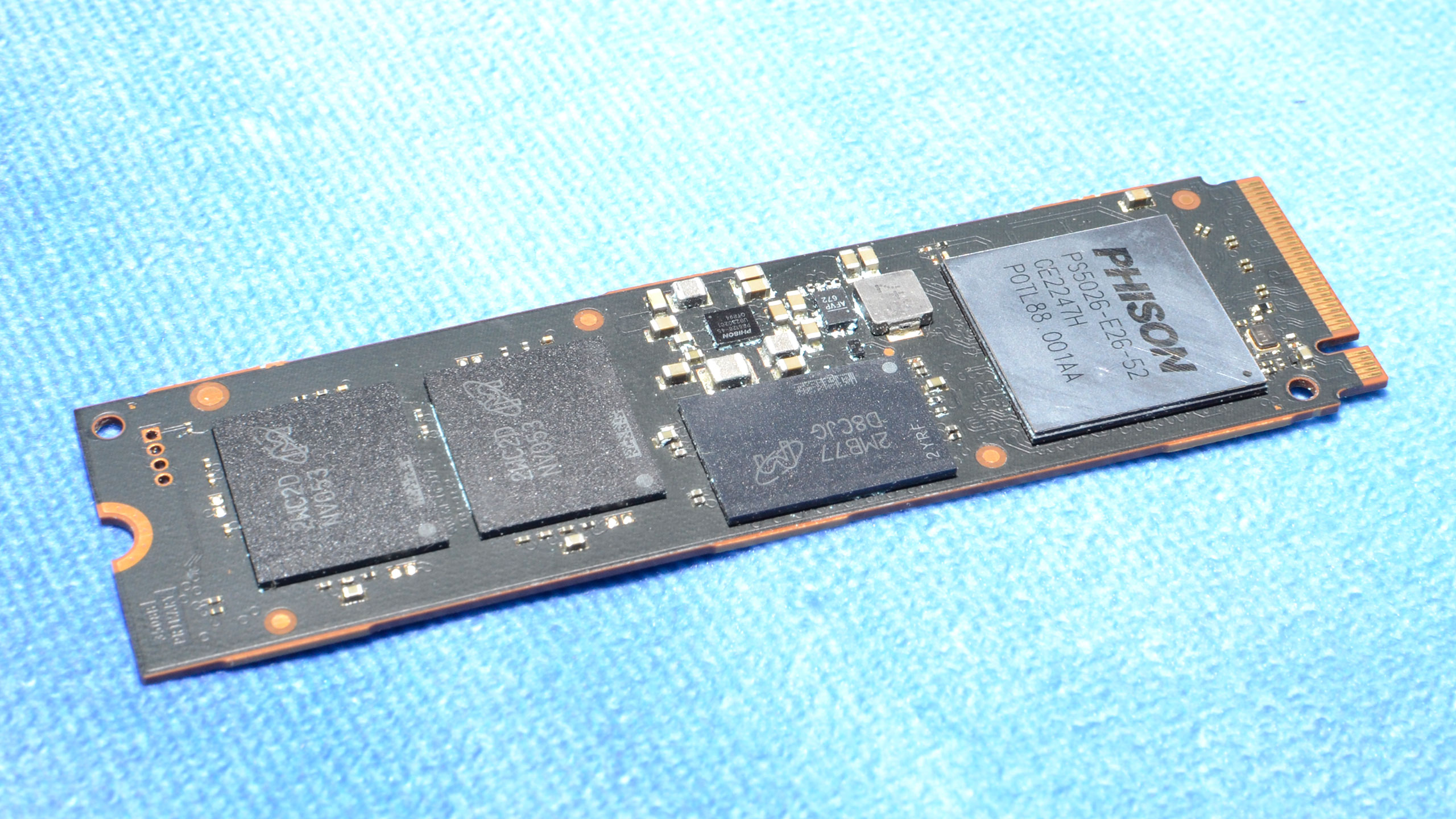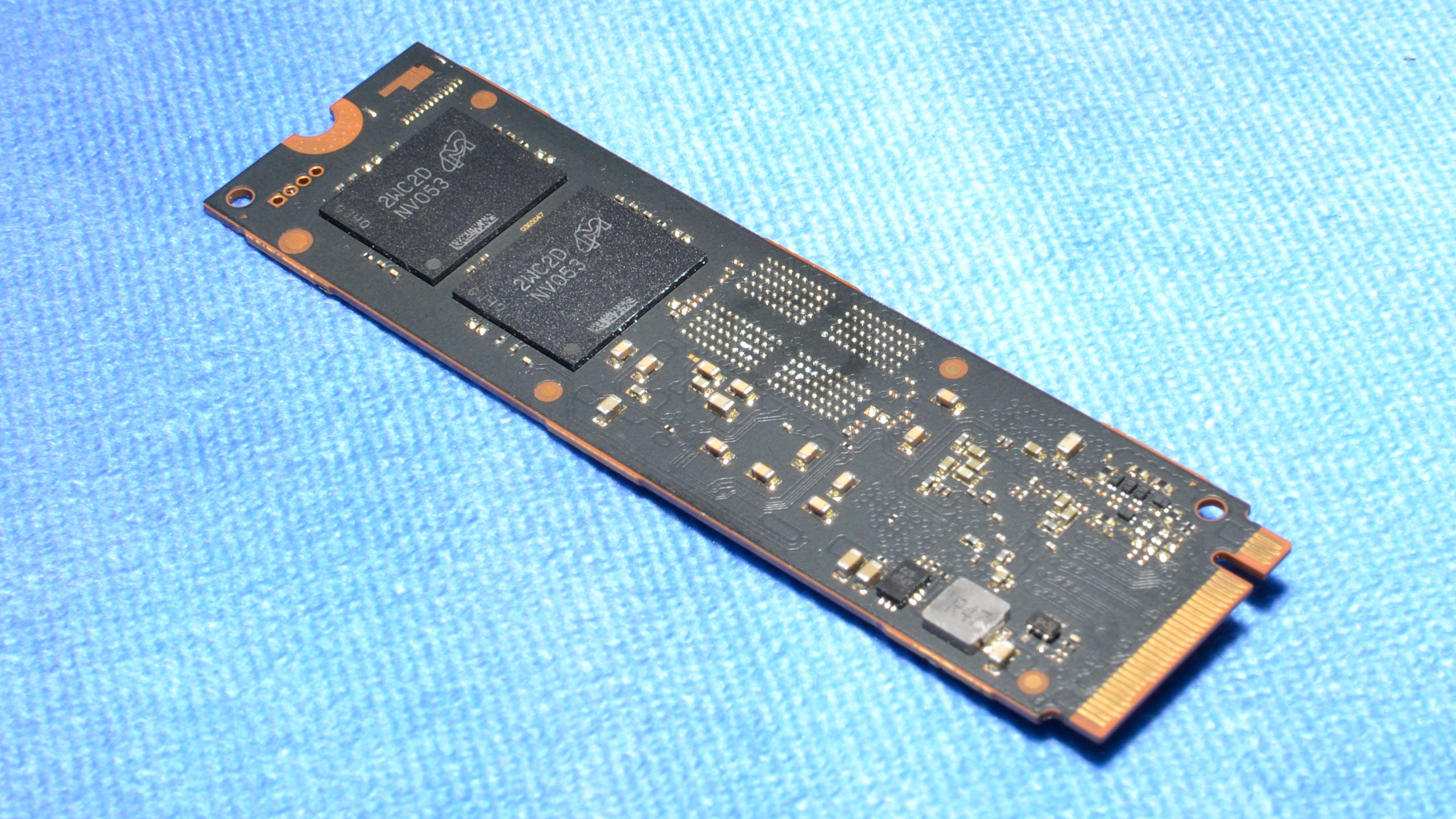Crucial T700 SSD Preview: Fastest Consumer SSD Hits 12.4 GB/s
The Crucial T700 sample we have in the labs today is unquestionably the fastest consumer SSD in the world, at least for now, delivering up to a blistering 12.4 GB/s of sequential throughput and 1.5 million random IOPS over the PCIe 5.0 interface. That's 70% faster than today's highest-end PCIe 4.0 SSDs, and 20% faster than the current crop of PCIe 5.0 drives.
The T700 is slated to be the first of a new set of faster PCIe 5.0 SSDs that offer even better performance than what we saw with the initial PCIe 5.0 SSD we covered in our Phison E26 SSD controller preview. The T700 uses the Phison E26 SSD controller, a robust design used in several other 5.0 SSDs, paired with speedy 232-Layer TLC flash, thus creating the fastest SSD we’ve ever tested in our labs. Impressively, it delivers this level of performance with passive cooling thanks to its well-designed heatsink, but if you remove the heatsink the SSD will also work well in motherboards with proper M.2 heatsink coverage.
The drive also comes with DirectStorage enabled, which will allow games that support the feature to deliver the utmost in performance. Crucial provided an early T700 sample to us for testing, and the drives will launch in a few months (by the end of the second quarter). Let's see what they'll look like when they arrive.
Specifications
| Product | 1TB | 2TB | 4TB |
|---|---|---|---|
| Pricing | TBD | TBD | TBD |
| Form Factor | M.2 2280 | M.2 2280 | M.2 2280 |
| Interface / Protocol | PCIe 5.0 x4 | PCIe 5.0 x4 | PCIe 5.0 x4 |
| Controller | Phison E26 | Phison E26 | Phison E26 |
| DRAM | LPDDR4 | LPDDR4 | LPDDR4 |
| Flash Memory | 232-Layer Micron TLC | 232-Layer Micron TLC | 232-Layer Micron TLC |
| Sequential Read | 11,700 MBps | 12,400 MBps | 12,400 MBps |
| Sequential Write | 9,500 MBps | 11,800 MBps | 11,800 MBps |
| Random Read | 1,350K | 1,500K | 1,500K |
| Random Write | 1,400K | 1,500K | 1,500K |
| Security | N/A | N/A | N/A |
| Endurance (TBW) | 600TB | 1,200TB | 2,400TB |
| Part Number | - | - | - |
| Warranty | 5-Year | 5-Year | 5-Year |
The Crucial T700 delivers up to 12.4 / 11.8 GBps of sequential read/write throughput and 1.5 / 1.5 million IOPS in random read/write workloads with the 2TB and larger models (the 1TB model is slightly slower). The drive will be available in 1TB, 2TB, and 4TB capacities, with pricing yet to be determined. Crucial backs the drive with a five-year warranty and endurance of 600TB of writes per 1 TB of capacity.
The drive supports AES-256 encryption and TCG Opal 2.01, including for crypto erase (TCG OPAL was not implemented at the time of testing). Crucial also has other optimizations in the works, but the drives we're testing are considered Engineering Samples (ES), so the firmware is not final. Crucial expects that performance in random write workloads will improve in the future.
Software and Accessories
Crucial offers its own Crucial Storage Executive SSD toolbox with the typical features you would expect. The utility includes drive information, SMART attributes, firmware updates, secure erase/sanitize, overprovisioning, and other features related to encryption. The T700 is not explicitly supported per Crucial’s website, but this will likely change when the drive arrives at retail. Third-party software like CloneZilla is recommended for cloning and imaging.
A Closer Look
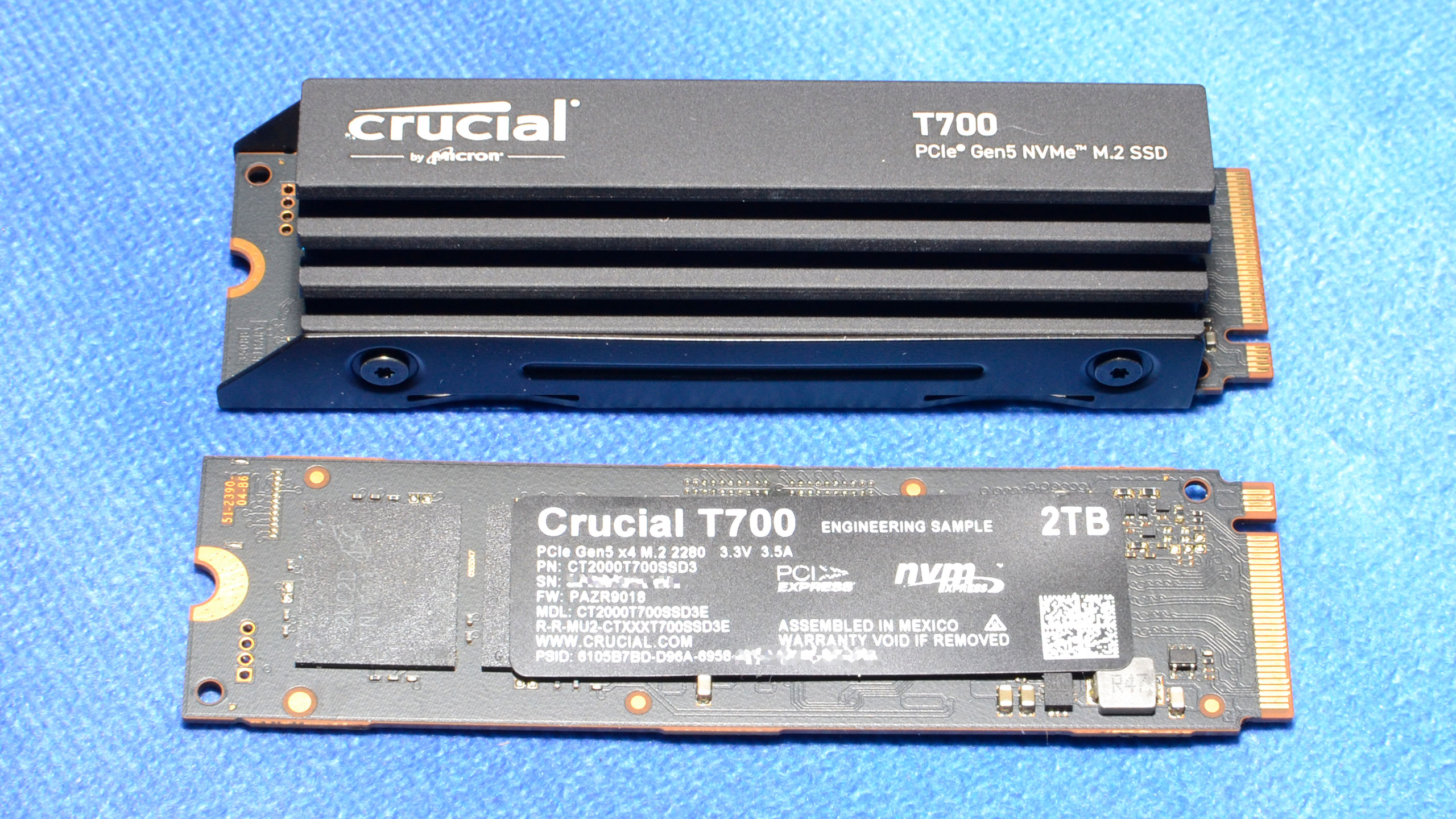
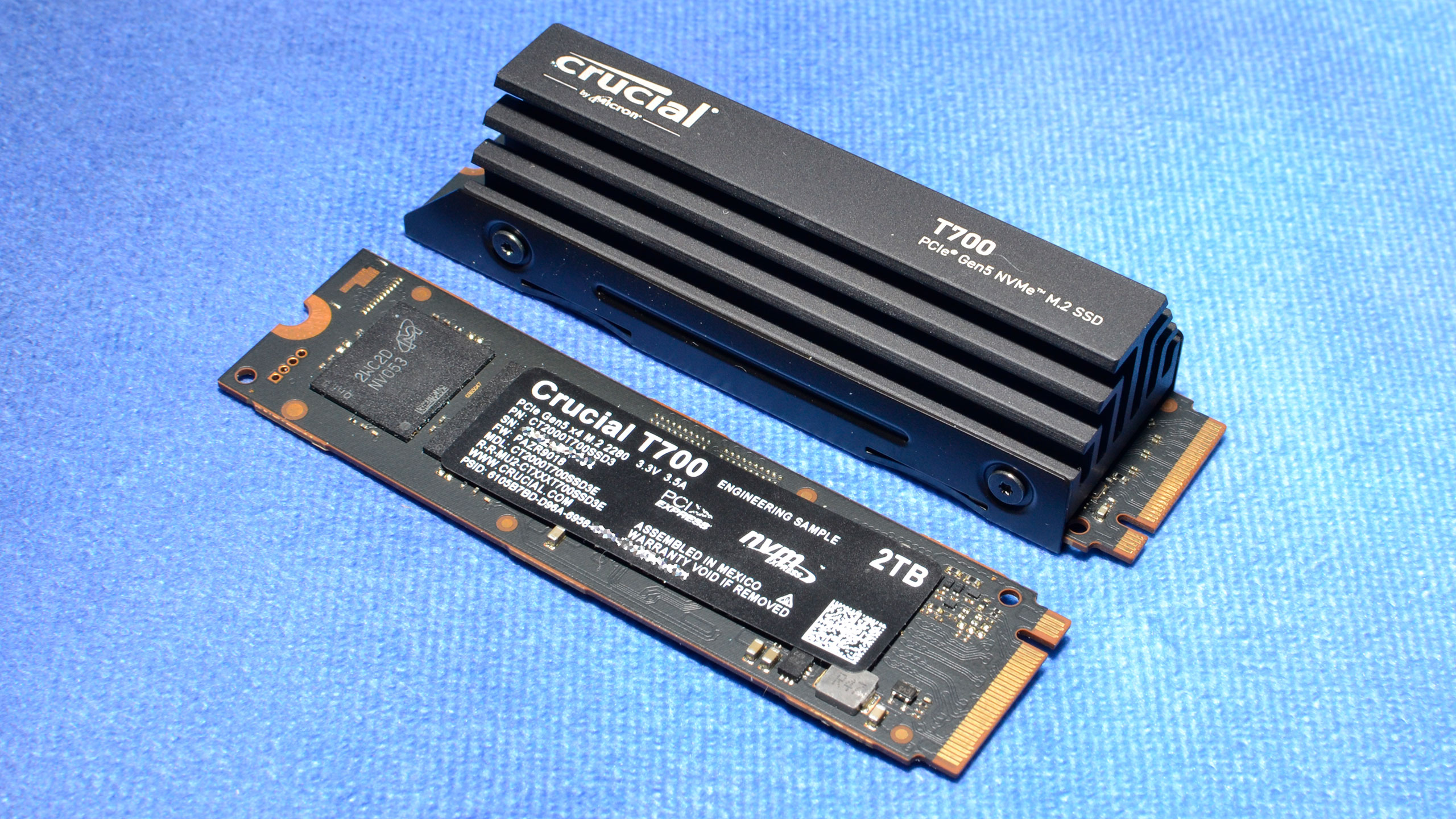
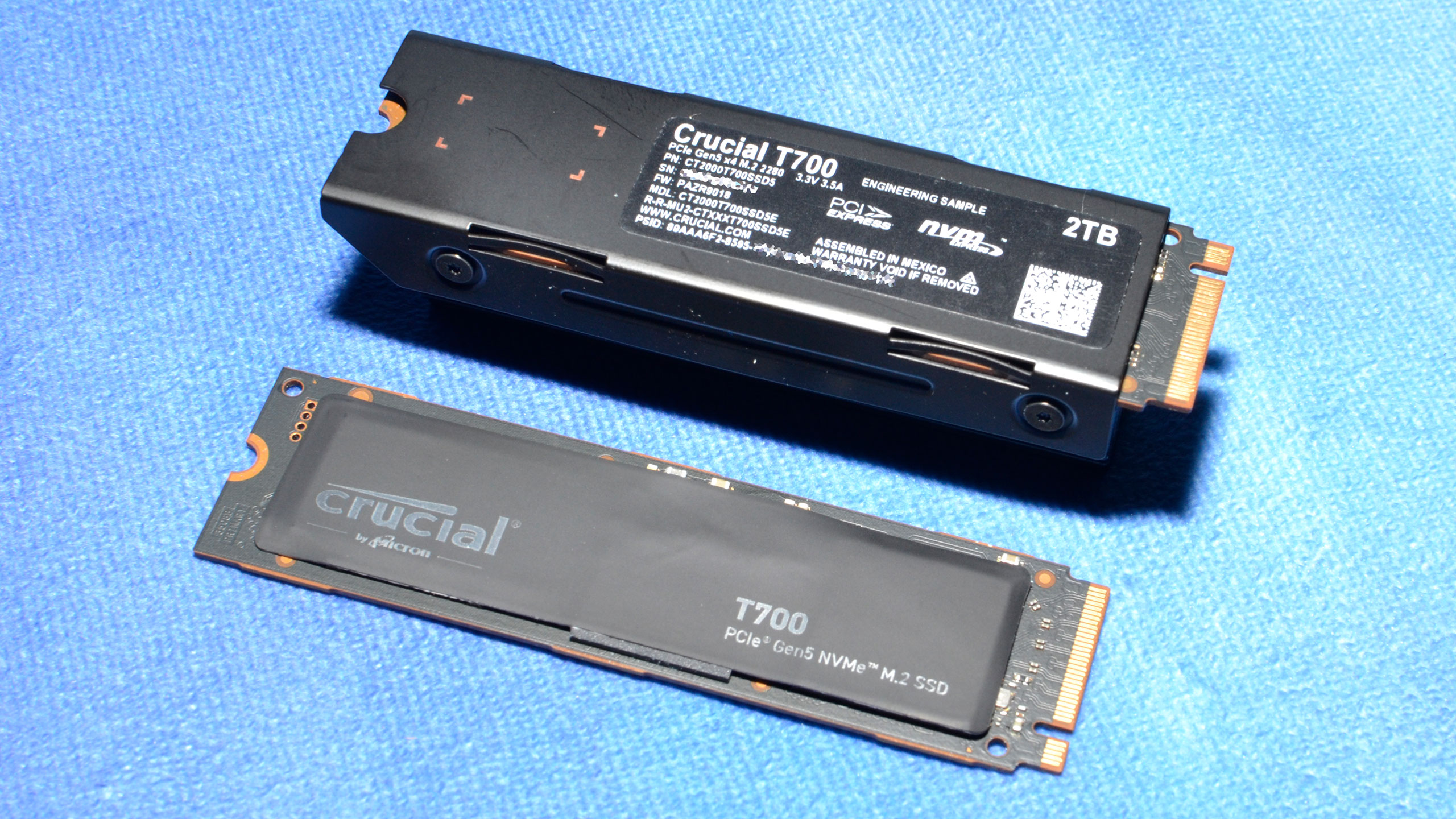
The T700 comes with or without a heatsink, depending on your needs. If your motherboard already has a substantial M.2 heatsink, or if you want to install your own solution, the bare drive is an option. In that case, the drive has a copper thermal label that is not intended to be removed. This SSD is not intended to be used without a heatsink, such as in a laptop or PlayStation 5.
The default model comes with a pyramidal, central T-pose heatsink designed to keep the drive cool without any (direct) active cooling. The heatsink is constructed of multiple materials and has air channels to maximize heat dissipation via airflow in the case. The SSD components — SSD controller, NAND flash, power management integrated circuit (PMIC), and voltage regulators — have good contact with the heatsink via thermal material. The back side of the heatsink is nickel-plated copper that provides support and heat spreading, while the top is aluminum with a significant amount of surface area for heat dissipation.
All T700 models are double-sided with two NAND packages per side, for a total of four. The top of the SSD has the requisite SSD controller package and a single DRAM package.
The Phison E26 is the first consumer PCIe 5.0 SSD controller to hit the market. We previously conducted preview testing of an engineering sample, and now a whole host of drives are arriving with this controller on board. This controller has DirectStorage-optimized firmware, which we also previewed before its official release. That firmware has already found its way into one PCIe 4.0 SSD, the Sabrent Rocket 4 Plus-G.
The T700 is not the first PCIe 5.0 SSD on the market, as the Inland TD510 has been out for a while. The T700 is also not the first to be announced by a big brand name, as we can see with the Corsair MP700. However, the T700 is the fastest implementation of the E26, as it can reach up to 12.4 GBps in sequential read workloads thanks to its speedier flash with an I/O speed of 2000 MT/s. This is in contrast to the 1600 MT/s flash used in the earlier E26 SSDs, limiting them to around 10 GBps. The E26 controller supports up to 2400 MT/s flash, which would put a cap of around 15 GBps. But for now, the T700 is the fastest around.
The T700 has DRAM identified as D7CJG, meaning this is LPDDR4 in a 1G x 32b configuration. LPDDR4 is more power efficient than DDR4 memory (we saw the benefit of LPDDR4X in our Lexar Professional NM800 Pro review). In this configuration, we have 4GB of DRAM for 2TB of NAND, the same as in our E26 preview. There may be reasons for such a high memory-to-flash ratio, but we'll have to review the amount used with other capacities.
The 232-Layer Micron TLC (B58R) flash takes up the mantle from Micron’s very successful 176-Layer TLC (B47R). Micron has gone from four planes to six and has made other improvements that make multi-planar operations faster for superior internal parallelization. The move to 1Tb (128GB) dies over 512Gb (64GB) is also an important consideration for capacity: bigger dies, more storage.
Denser dies also mean less relative parallelization for the same capacity because fewer dies are required. This is mitigated to some extent by the increase in internal parallelization, or planes. The T700 can still reach peak performance at 2TB like older PCIe 4.0 SSDs, but has the opportunity to be better at 4TB as well, depending on multi-planar optimizations. The performance of TLC flash during sustained write workloads could also improve without a corresponding improvement to read latency, although read performance as a whole should improve due to independent plane advancements.
MORE: Best SSDs
Get Tom's Hardware's best news and in-depth reviews, straight to your inbox.
MORE: Best External SSDs and Hard Drives
MORE: How We Test HDDs And SSDs
MORE: All SSD Content

Shane Downing is a Freelance Reviewer for Tom’s Hardware US, covering consumer storage hardware.
-
edzieba ReplyThis SSD is not intended to be used without a heatsink, such as in a laptop or PlayStation 5.
It would be illuminating to test without a heatsink anyway. The current drive only starts to throttle after 0.2-0.25 TB continuous writes, so based on testing of previous drives without heatsinks, it's quite likely the only effect from operating this drive without a heatsink would be reducing that threshold to 'only' 100 GB or so. I would expect any testing that does not involve throwing around continuous hundreds of GB of data would not see any significant (or any) performance impact from removing the cosmetic greebly. -
JarredWaltonGPU Reply
If you're doing stuff that doesn't throttle, you probably also don't need to buy a Gen5 SSD. I mean, PS5 doesn't support Gen5 anyway, so there's literally zero performance benefit. Anyway, the nature of our SSD benchmarks is that a lot of the tests are of short enough duration that they won't hit the throttling mark. The problem is stuff like CrystalDiskMark that takes quite a bit longer to run and will thus start to throttle hard on later tests. Which results are "valid"? If we take the maximum performance measured in a given test, we can make it look like having a heatsink doesn't matter.edzieba said:It would be illuminating to test without a heatsink anyway. The current drive only starts to throttle after 0.2-0.25 TB continuous writes, so based on testing of previous drives without heatsinks, it's quite likely the only effect from operating this drive without a heatsink would be reducing that threshold to 'only' 100 GB or so. I would expect any testing that does not involve throwing around continuous hundreds of GB of data would not see any significant (or any) performance impact from removing the cosmetic greebly.
But here's a good indicator of the worst-case scenario for the Crucial T700: with and without a heatsink in our write saturation and ATTO testing. Throttling only kicks off in ATTO at 2MiB block size, meaning everything less than that wasn't hit the thermal limit. But that's only if you start the drive from a "rested" (not hot) state. For IOMeter Write Saturation, starts after 25 seconds of sustained writes. Granted, given the speed, that's still enough time to write about 200–250 GB! 🙃
216215
217218
It's important to note that Crucial explicitly states that a heatsink or some form of cooling is required. Running it without a heatsink effectively voids the warranty and could result in a damaged drive. Don't buy a Gen5 drive and use it without a heatsink, in other words. (Testing the T700 in our Asus board with the motherboard heatspreader results in effectively identical performance to Crucial's own cooler, incidentally. YMMV depending on your particular mobo, heatspreader, and case configuration, naturally.) -
atomicWAR I feel like we're hitting the point of diminishing returns for SSD speeds in consumer PCs. This extra speed is nice in theory but between the heat and the fact I can barely tell the difference in my PCIe 3.0 drives that max out the bus vs my PCIe 4.0 drives that do the same. Game load times are probably the easiest place beside large file transfers to spot the speed ups and even there the difference feels almost moot when its a 11 sec game load time vs a 9 sec one (or something like that). Plus we went from small passively cooled Pop tart sized 2.5" drives to cool little 'sticks of spearmint gum' that could be slid in anywhere on your motherboard with nothing or maybe a small heat sink, to now requiring large heat sinks and in some instances a fan as well to keep things cool.Reply
Until manufacturers do more with solid state cooling to keep things cool, quiet and compact (or something different than the current heat sinks)...I think most folks will stick to drives their built in motherboard heat sinks can handle making a lot of the PCIe 5.0 nvme drives unattractive. I could be wrong but I know I choose to go all 3.0/4.0 and avoid waiting for 5.0 drives for the reasons of heat and speed I brought up. I did get some beefy passive after market coolers for my two fastest 4.0 drives that max the bus out due to throttling issues I was facing with stock motherboard heat sinks and a couple smaller light wait ones due poor airflow the built in motherboard heat sink had beneath my gpu. I placed my slowest coolest drives here but they again they throttled without better cooling (running one drive was ok but running both drives they over heat the shared heat sink). Until better more compact, quiet cooling is in place I think fast PCIe 5.0 nvme drives will face some adoption issues among home users. -
JarredWaltonGPU Reply
Yeah, Gen5 SSDs are very much less about typical consumer use and more for specific use cases like servers. Still, I'll say that verifying a Steam install (or doing a big update to an installed Steam game) can go a lot quicker on a Gen4 or Gen5 SSD. 🙃atomicWAR said:I feel like we're hitting the point of diminishing returns for SSD speeds in consumer PCs. This extra speed is nice in theory but between the heat and the fact I can barely tell the difference in my PCIe 3.0 drives that max out the bus vs my PCIe 4.0 drives that do the same. Game load times are probably the easiest place beside large file transfers to spot the speed ups and even there the difference feels almost moot when its a 11 sec game load time vs a 9 sec one (or something like that). Plus we went from small passively cooled Pop tart sized 2.5" drives to cool little 'sticks of spearmint gum' that could be slid in anywhere on your motherboard with nothing or maybe a small heat sink, to now requiring large heat sinks and in some instances a fan as well to keep things cool.
Until manufacturers do more with solid state cooling to keep things cool, quiet and compact (or something different than the current heat sinks)...I think most folks will stick to drives their built in motherboard heat sinks can handle making a lot of the PCIe 5.0 nvme drives unattractive. I could be wrong but I know I choose to go all 3.0/4.0 and avoid waiting for 5.0 drives for the reasons of heat and speed I brought up. I did get some beefy passive after market coolers for my two fastest 4.0 drives that max the bus out due to throttling issues I was facing with stock motherboard heat sinks and a couple smaller light wait ones due poor airflow the built in motherboard heat sink had beneath my gpu. I placed my slowest coolest drives here but they again they throttled without better cooling (running one drive was ok but running both drives they over heat the shared heat sink). Until better more compact, quiet cooling is in place I think fast PCIe 5.0 nvme drives will face some adoption issues among home users.
There's also the question of how much DirectStorage could make faster SSDs useful in games. I suspect even if done properly, we're still looking at a current maximum of maybe 10-20GB of data for a game engine, level, and textures. So, you could potentially do 20GB in under two seconds with Gen5, versus three seconds with a fast Gen4, versus five seconds with a fast Gen3. But when I launch stuff like Red Dead Redemption 2 and it takes over a minute to get into the game, any of those sounds amazing! -
atomicWAR Reply
Yeah I couldn't agree more. In the enterprise/server space SSDs speeds will always be hungry for more bandwidth/IO. And with direct storage we may see some uses down the line but for now I think any fast 4.0 SSD is more than enough for most home users.JarredWaltonGPU said:Yeah, Gen5 SSDs are very much less about typical consumer use and more for specific use cases like servers. Still, I'll say that verifying a Steam install (or doing a big update to an installed Steam game) can go a lot quicker on a Gen4 or Gen5 SSD. 🙃
There's also the question of how much DirectStorage could make faster SSDs useful in games. I suspect even if done properly, we're still looking at a current maximum of maybe 10-20GB of data for a game engine, level, and textures. So, you could potentially do 20GB in under two seconds with Gen5, versus three seconds with a fast Gen4, versus five seconds with a fast Gen3. But when I launch stuff like Red Dead Redemption 2 and it takes over a minute to get into the game, any of those sounds amazing! -
USAFRet Reply
We hit that going from PCIe 3.0 to 4.0.atomicWAR said:I feel like we're hitting the point of diminishing returns for SSD speeds in consumer PCs.
In some use cases, SATA III SSD to NVMe.
The big jump was HDD to SSD. -
DavidLejdar Nice stuff. With current-gen software, it may not seem worth it to get it for. But the technical possibility to load 64 GB into RAM in about 5 seconds (and if needed, reload), that's that. And e.g. both RTX 4090 and RX 7900 XTX have 24 GB of VRAM. So it is not like there would be nothing to load the data to.Reply
Whether in particular video game devs will make full use of it, such as to depict e.g. cities to not look like Stalinist Moscow (that is using one type of texture, which gets reused on various walls, and therefore doesn't need to load much when such a texture fills half the screen, with three types of balconies reused to make it look not as monotone) - that isn't clear of course. But the option is there, including moving towards 8K, and not using artificial loading screens, such as an elevator ride between 2 areas as the only option to move between these two areas. -
Amdlova I have a adata pcix 4x placed on pcix 3 showing on software pcix 2... it's working that matters.Reply
Pci 5 only will be good for server. For desktop for now only heat and compatible issues. Maybe two years beyond to be slim and the software can use that speed. -
TechieTwo Reply
There are no heat nor compatibility issues as long as you are using a PCIe 5 M.2 mobo. Don't be fooled by the elephant sized heatsinks that some companies are supplying with Gen 5 SSDs. In most if not all cases the mobo supplied SSD heatsink/cover plate is more than enough cooling to prevent throttling. The large heatsinks are a marketing ploy.Amdlova said:...
Pci 5 only will be good for server. For desktop for now only heat and compatible issues. Maybe two years beyond to be slim and the software can use that speed.
While the Gen 5 SSDs are almost 7 months late they have merit for some desktop applications. They will not offer any practical advantage over PCIe 3 or 4 unless you are moving a lot of data at once. -
PBme ReplyatomicWAR said:I feel like we're hitting the point of diminishing returns for SSD speeds in consumer PCs.
It isn't about cooling or anything else being needed to help them max out. It is diminishing returns as this max speed is only for sequential writes for large massive video file to another drive that is this fast. And even that is very time limited. For all the smaller writes these drives aren't showing meaningful difference two pcie 3 drives. Just a very specific and not common use case is what is being increased and advertised. Sets folks up for upgrade disappointment.
